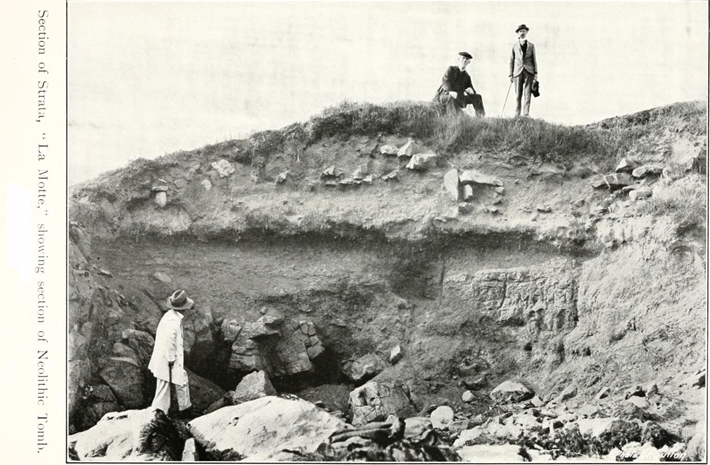Images from photo archive:


Archaeological excavations carried out between 1911 and 1914 showed that the islet had been occupied over a long period of time. Despite being quite small the site is unusual because it had several both ritual and domestic elements, as well as providing important environmental evidence relating to changes in sea level. The remains of a series of prehistoric rubbish heaps, dating between 1,500-300 BC, containing fragments of pottery, animal bones, stone tools and shells were found.
Group of 18 cists which were excavated were dated from the Bronze Age to the Iron Age. Two cists can be found at La Houge Bie.
Cist: An ancient coffin or burial chamber made from stone or a hollowed tree

La Motte is a tidal island, and listed archaeological site, also known as Green Island, located in the Vingtaine de Samarès in the parish of St Clement on the south-east coast of Jersey, Channel Islands.
The island has a grassy surface and is predominantly clay surrounded by rocks. In recent times efforts have been made to reduce erosion of the island by the construction of walls.

Some archaeological evidence has been found here. Remains of a cemetery on La Motte are believed to be from later settlers. There are Neolithic elements including a cairn and a number of middens, dating from 1500 BC to 300 BC, on La Motte.
http://photographic-archive.societe-jersiaise.org/Details/archive/110003728

To the east of Grève d’Azette beach lies Le Croc du Hurté. In the medieval period this small promentory actually extended out to what we now know as Green Island or to give it its old name, La Motte – the mound. Richard Popinjay from Portsmouth drew a map of Jersey for Queen Elizabeth I in 1563 which shows La Motte still part of the main island. At some stage in the 17th century a severe storm must have caused the waves to smash and wash away the thin strip of land connecting it to Le Croc du Hurté.
/arc-anglerfish-arc2-prod-jerseyeveningpost-mna.s3.amazonaws.com/public/BTV2F7FIYZCOJMDC3F7QT23XG4.jpg)


In September 1858 some children found a skeleton buried on the islet. The mystery was cleared up at the coroner’s inquest by 82-year old James Le Templier who said that he had discovered the body sewn in a hammock washed up on the islet about 50 years earlier. As there had been a naval engagement between a Royal Navy vessel and a French Navy brig a few days before, the Constable of St Clement declared the body to be that of a French sailor and ordered the soldiers from the Roqueberg battery to bury it on La Motte.
https://jerseyeveningpost.com/news/2009/10/23/witch-trials-in-jersey-fact-or-fiction/
https://jerseyeveningpost.com/features/2015/05/03/coast-gallery-spotlight-on-green-island/
The slipway, La Montée de la Sordonnière, was built about 1870 and takes its name from the beach – sordonnière means a sea slug.
At the far end of the beach is Rocqueberg. A guardhouse with an associated magazine was built here in 1691 from which the men of the St Clement’s militia kept a look-out in times of emergency. In the late 18th century two 24-pounder cannon were positioned here on a wooden platform behind an earth wall or boulevard.
In 1797 an accidental explosion destroyed the original guardhouse and because of financial constraints it was not replaced until 1802. By then a small detachment of the regular army was based here and it was these men who were tasked with burying the French sailor on Green Island.
